#Clive Phillpot
Explore tagged Tumblr posts
Text
Books On Books Collection - Megan N. Liberty
Craft & Conceptual Art : Reshaping the Legacy of Artists’ Books (2023) Craft and Conceptual Art: Reshaping the Legacy of Artists’ Books (2023) Megan N. Liberty, ed. Perfect bound, embossed and ink printed cover. H302 x W229 mm. 118 pages. Acquired from San Francisco Center for the Book (CODEX), 5 February 2024. Photos: Books On Books Collection. Megan Liberty’s traveling exhibition and…

View On WordPress
#Anna Sigridur Arnar#Barbara London#Betty Bright#Center for Book Arts NYC#Clive Phillpot#Daniel Fendrick#David Senior#Diannne Perry Vanderlip#Franklin Furnace#German Celant#Horace Brockington#Jacki Apple#Joan Hugo#Johanna Drucker#Judith Hoffberg#Manfred Schneckenburger#Marta Minujin#Martha Wilson#Megan N. Liberty#Minnesota Center for Book Arts#Moore College of Art#Norman Colp#Penelope Suess#Peter Frank#Printed Matter Inc.#San Francisco Center for the Book#Steve Woodall#The Writer&039;s Center#Walker Art Center
0 notes
Text
Understanding Artists' Books
The Paul D. Fleck Library & Archives holds over 5,000 artists' books - and the collection continues to grow through a combination of donations and purchases every year.
But what is an artists' book?
Well, part of the (usually exciting) challenge of artists' books is that they're difficult to define. For the Emily Carr University Art and Design library, the artists' book collection "encompasses books conceived, crafted, published, produced or altered by an artist, designer or collective with the intention of creating an independent art work ." But for the Smithsonian Library, "[a]n artist’s book is a medium of artistic expression that uses the structure or function of 'book' as inspiration—a work of art in book form." Our collection sits somewhere in between, encapsulating works in both of these definitions - and some works that are beyond either. In our library, you'll find do-it-yourself zines and handmade chapbooks from small presses, sculptural pieces, weavings, objects, comic art, flipbooks, and dozens of other specific forms.
Our collection began in 1985, when the director of the Walter Phillips Gallery, Lorne Falk, handed Bob Foley (Banff Centre's first full-time librarian) a suitcase's worth of artists' books and said, "These are yours, you should do something with them." Through a meeting with AA Bronson, an artist who founded Art Metropole and the New York Art Book Fair, Foley expanded the collection by developing relationships with publishers and distributors. Since then, the collection came to include artists such as Dieter Roth, Ed Ruscha (whose artists' book Every Building on the Sunset Strip inspired the creation of this tumblr page!), Barbara Kruger, Joseph Beuys, Mieko Shiomi, Yoko Ono, Gertrude Stein, and John Cage.
Please take your time to explore our tumblr and our library catalogue - and if you ever get the chance, please come and explore our artists' books in person. The library staff are always excited to answer questions or help you find what you're looking for.
If you'd like to read more about artists' books, consider these books:
Aarons, Philip E. and Andrew Roth, editors. In Numbers: Serial Publications by Artists Since 1055. Zurich: PPP Editions, 2009.
Arnar, Anna Sigrídur. The Book as Instrument: Stéphane Mallarmé, the Artist's Book, and the Transformation of Print Culture. Chicago: University of Chicago Press, 2011.
Castleman, Riva. A Century of Artists Books. New York: Museum of Modern Art; distributed by Henry N. Abrams, 1994.
Drucker, Johanna. A Century of Artists' Books. New York: Granary Books, 1995.
Phillpot, Clive. Booktrek: Selected Essays on Artists' Books since 1972. Zurich: JRP Ringier, 2013.
9 notes
·
View notes
Text
Experimental Publishing Lecture with Can Yang
PRE - POST - PRINT
Artist books - fruit salad diagram, book objects, book art, literary books - Clive phillpot 1982
Book on book - bibliography of books - Arnaud Desjardin
Other books - Ulises Carrión
The book - Klaus Sherübel, Mellarmé (2014) - the book is performing as a traditional book
Book as object - approach the book as a physical object
The barcode source book
200 fortunes - Ben Denzer
Book as archive - Bruce Milne and Andrew Maine - Fast Forward Zine
Queer.archive.work
Can Yang - Weekly Informed
Print to digital - kione kochi - updated version of the fruit salad diagram - illustration - difference between original and updated shows how arts publishing has changed by digital and post digital practices
Print to E-books - a hybrid publishing toolkit for the arts
Digital publishing - “paperless revolution”. Present tense pamphlets
Kulambo bulleting - tumblr site
Post digital publishing - ideology press
Ubuweb - milestone in post digital publishing - digital archive for artistic media
Paul Soulellis - library of the printed web - exists in printed format and Google document format
Independent and institutional platforms: Monoskop.org - wiki for collaborative arts. Aaaaaarg, monoskop, public library, ubuweb, have emerged offering access to humanities texts and audio visual resources. Printed matter, inc - let self publishing artists be seen by the public. Temporary service - website provides pdf versions and printed versions.
0 notes
Text
Pre-Post-Print Experimental Publishing - Can Yang
Notes:
Diagram: fruit salad 1982
Book objects book art and literary books
Clive Phillpot
Book track- how book art presents itself
Book on Book
Ulises Carrion founded Other Books
Het Boek - inspired by French poet-made out of foam
The book is performing as a traditional book
“No need to read a sample of the work sufficed to authenticate its existence”
Interesting to think between a book and performance art
Ben Denzer
Book as archive - Fast Forward zine
Queer.archive
Weekly informed is a collection of weekly presentation of 10 example of form that relates to practise and methodology
Guai Li Luan Shen - hidden culture
The difference between diagrams show how art publishing has changed by digital and post digital practises
“The term publication is better because it can encompass digital files, hybrid media and forms we have yet to imagine”
Present Tense Pamphlets
The hazards of witnessing-extract on a digital zine on tumblr
Takachizu website that documents artefacts and objects serving as the collective memory
Onpublishingpage - you can make a book and format your page layout
Suki and Ming- famous Korean designers
Ideology press- a propositional publishing process
Earliest format of digital publication: Kenneth Goldsmith Publishing the Unpublishable serves a publication for alternating content
Paul Soulellis Library of the Printed Web- exists online and in printed web google doc
“Printed web was a fitting venue to perform and celebrate this slippery condition”
Monoskop.org - useful for art and cultural studies (research, articles can be downloaded from here)
“Information wants to be free”
Digital libraries: Aaaaaarg, Public library, UbuWeb -technically pirated and often hard to find elsewhere
Printed Matter Inc- a famous art book fair in America. Founded by art historian and xox Sofia’s artist. Non profit. If you have your own zine, feel free to contact them.
New community with educational programmes that often reach diverse locations. 45,000 works in their archive.
Temporary Service - offer zine and riso printing. Site has PDF versions of books.
Book Binding Workshop:

Due to no previous sessions in bookbinding, I had no idea how to approach this and so I have nothing to show for it. I have learning difficulties which makes it very hard for me to understand measurements, technicalities etc and I need consistent support (someone to sit with me and show me how to do things), which of course, isn't possible in a classroom setting. The same issue has affected me in my process book creation, so I resort to using my finances to pay for its print and binding. I will try this weekend with the help of my boyfriend to make a book.
Update:
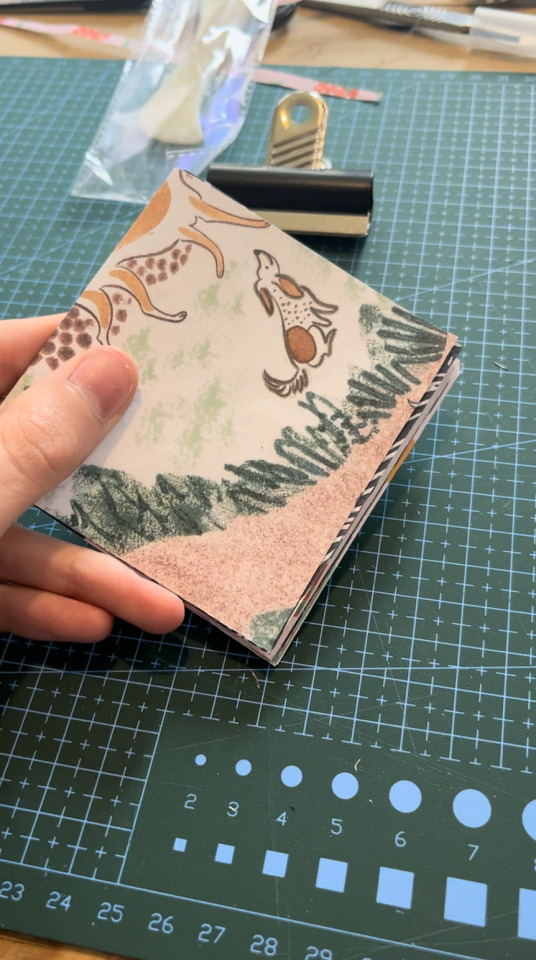
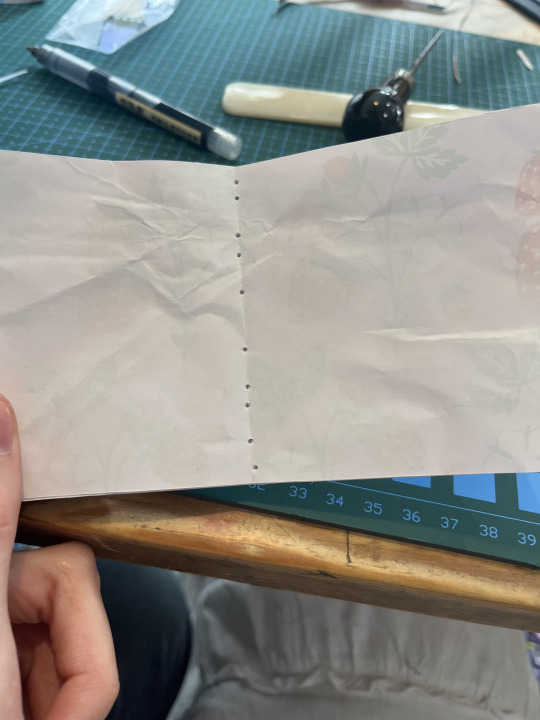

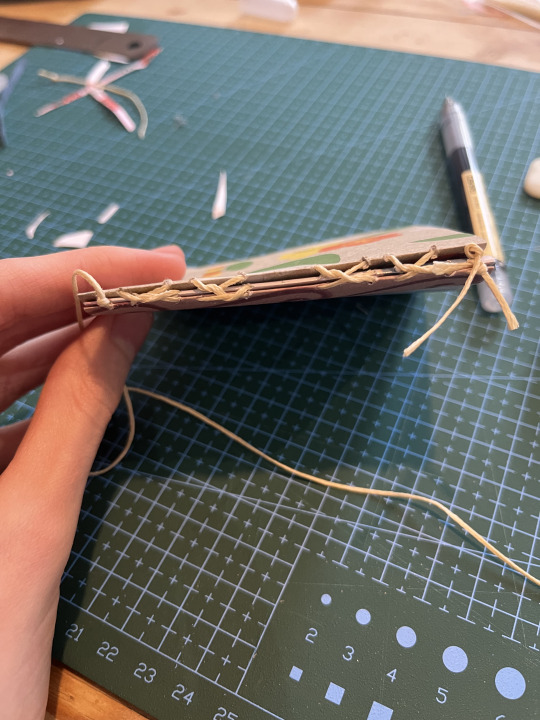
Using a Youtube tutorial and my boyfriend's support, I was able to make a mini book using the French stitch bind method!
1 note
·
View note
Photo


#artbooks#moma#Clive Phillpot#artists books#diagram#kione kochi#illustration#risograph#selfpublishing
3 notes
·
View notes
Photo

The Small Press Project
Institute of Advanced Studies, South Wing, UCL
Thursday 27th April | 10am – 4pm
I’m excited to announce the second annual event inspired by the Little Magazines, Alternative Press & Poetry Store Collections held at UCL. Organised by the Slade School of Fine Art. I’ve been working alongside Liz Lawes, UCL’s Art Librarian and Lesley Sharpe, Teaching Fellow in Print to organise this and it’s going to be a great event for anyone interested in Small Press and Independent artists’ publications.
Speakers/participants
Clive Phillpot, artist, historian and Small Press Expert; Elizabeth Lawes, UCL Small Press Collections; Eleanor Von Browne, X Marks the Bokship; Professor Sharon Morris, Slade School of Fine Art, UCL; Morel Books; Banner Repeater; Arnaud Desjardin, The Everyday Press, Bunker Basement; Central Saint Martin students; Hannah Dargavel-Leafe; RCA students; Camberwell School of Art students;
Exhibition
The Small Press Project coincides with an exhibition of publications inspired by the UCL Collection made by students and staff at the Slade School of Fine Art. The exhibition will run from 26th April – 28th April in the North Lodge, Main Entrance of UCL on Gower Street, and will be open between 11.00am - 5.00pm daily.
http://www.ucl.ac.uk/slade/events/small-press-project-2017
#small press#slade school#artist publications#ucl#event#exhibition#special collections#sarah pickering#lesley sharpe#liz lawes#sharon morris#bunker basement#clive phillpot#arnaud desjardin#banner repeater
0 notes
Text
리딩룸 – 실천으로 예술출판

더 북 소사이어티에서 리딩룸을 함께 할 분들을 모집합니다. 총 6회에 걸쳐 격주로 함께 글을 읽고 토론하는 리딩룸의 이번 주제는 “실천으로 예술출판”입니다. 새로운 비더마이어 시대로 불리는 지금 우리는 여전히 많은 책을 만들고 이것을 소비합니다. 하지만 상대적으로 이러한 문화에 대한 담론은 부족한 상황입니다. 우리는 함께 글을 읽고 토론하면서 이러한 문화의 새로운 가능성에 대해 이야기를 나눌 생각입니다. 몇 가지 소주제나 예상되는 리딩 리스트들이 있긴 하지만 기본적으로는 참여하시는 분들의 성향이나 관심사, 능력에 따라 함께 읽을 글이나 주제들이 결정될 것입니다. 이번 리딩룸의 참여자들은 예술 출판과 관련하여 자신이 관심 있는 주제나 작가, 출판사, 편집자들이 만든 책에 대해 이야기하고 자신 만의 관점에서 이 주제를 발전시킬 기회를 가질 수 있을 것이라고 생각합니다. 앞에서 언급한 것처럼 이번 리딩룸은 좀 더 열린 형식으로 진행됩니다. 기본적으로는 총 6회에 걸쳐서 동시대 예술출판에 대한 글들을 선정하여 함께 읽겠지만, 참여자의 관심사에 따라 리딩 리스트 이외 다른 소주제가 추가될 수 있습니다. 또한 특정한 작가나 기획자, 편집자의 책에 대해 이야기하고 직접 아티클을 생산할 수도 있습니다. 기본적으로는 매주 1~2개의 아티클을 발제하고 여기에 대해 토론을 진행하는 형식으로 진행됩니다.
키워드: 예술출판, 소규모 출판, 아티스트 북, 진ZINE, 뉴비더마이어, 마이크로 페어, 저장소, 포스트디지털, 소규모 서점, 기관출판, 인포샵, POD
일시: 6월 중순부터 격주로 총 6회 예정 (참여자 일정에 따라 요일과 시간이 결정됩니다) 장소: 더 북 소사이어티 통의동 참여비용: 무료 모집인원: 5명 내외
자격 책이나 글을 읽고 함께 토론하는 리딩그룹입니다. 전문적인 독해 능력을 필요로 하진 않으나 해당 영문 아티클을 발제하고 함께 토론할 수 있는 분이 참여할 수 있습니다.
참여방법 아래 이메일로 간단한 자기소개와 참여 동기를 A4 3장 내외로 작성해서 6월 10일 월요일 오전 12시까지 보내주시기 바랍니다. 적당한 참여자가 없는 경우에 마감이 연장될 수 있습니다. [email protected]
예상 리딩 리스트
Publishing as artistic practice, Sternberg Press, 2016 Publishing Manifestos, Miss Read, 2018 No-ISBN, Salon fur Kunstbuch, 2017 On the art and politics of radical publishing, Minesota Press, 2016 Booktrek, Clive Phillpot, Jrp Ringier, 2013 Lost and Living (in) Archives – Collectively Shaping New Memories, Annet Dekker (Ed.), 2017
* 이 프로그램은 서울시 ‘서울형 책방’ 사업의 지원을 받았습니다.
1 note
·
View note
Photo

Please Come to the Show / Available at www.draw-down.com / Designed by #SaradeBondt / David Senior, bibliographer at the Museum of Modern Art Library in New York, selected a wide range of exhibition-related ephemera—invitations, flyers and posters from the 1960s to the present—and presents them in this volume as an historically overlooked but integral aspect of exhibitions. Often the first point of contact between the audience and artist, such items form part of an essential lexicon for graphic designers, curators, art historians and anyone interested in the event-based nature of showing art. Filled with full-color reproductions of numerous examples from the #MoMA collection, the book includes essays and analysis by Angie Keefer, Clive Phillpot and Will Holder, among others. #design #graphicdesign #typography (at MoMA The Museum of Modern Art) https://www.instagram.com/p/BsC4D0JArF_/?utm_source=ig_tumblr_share&igshid=n6dnnkcnt9vo
10 notes
·
View notes
Text

Edward Ruscha, Twentysix Gasoline Stations
Born in Nebraska in 1937 Ed Ruscha grew up in the mid-west city of Oklahoma. Following an early interest in cartooning, Ruscha pursued a career in commercial art, heading west to Los Angeles to enrol at the Chouinard Art Institute in 1956. During this period of study he also undertook a short apprenticeship in type-setting and at the completion of his studies in 1960 worked as a graphic artist in an advertising agency. Exposed to and encouraged by the work of Jasper Johns, Robert Rauschenberg and Roy Lichtenstein, Ruscha dedicated himself to painting. In 1962 his work featured alongside that of Andy Warhol and Lichtenstein in ‘New painting of common objects’ a survey show that captured the emergence of the pop art scene.
Although he considers himself primarily a painter, Ruscha has worked across a variety of mediums – printmaker, draftsman, photographer, film-maker, book-maker. His series of photographic artist books which began in 1962 with ‘Twentysix gasoline stations’ were incredibly popular upon release and remain highly influential.
- Art Gallery NSW
Twentysix Gasoline Stations, a modest publication consisting of black and white photographs with captions, is an iconic artist book. The photographs are of petrol stations, along the highway between Ruscha’s home in Los Angeles and his parent’s house in Oklahoma City. Clive Phillpot, writer, curator and former Director of the Library at the Museum of Modern Art, New York, observes that the photographs are not reproduced in a linear sequence, with five photographs out of order.1 Taken from the highway and often including large areas of forecourt or road, the shots appear to be simply factual records of the petrol stations. Each opening of the book reveals one or two photographs in varying but repeated layouts, with the photographs set in relatively large areas of white space. The captions consist of the name of the petrol station and its location (for example, ‘Texaco, Sunset Strip, Los Angeles’ and ‘Flying A, Kingman, Arizona’).
- Tate
Personally, I am in love with this idea.
For me, gas stations are an unmatched aesthetic of a road trip that covers 500+ kilometers in a day. Gas stations are waking up at six am and packing yourself into the passenger front seat of the car, the dog whining in the back and the air so cold that we wear coats even inside the car. Making special 20 hour playlists for the ride and watching the scenery cha ge behind the windows every ten minutes.
Gas stations are a McDonald’s breakfast at eight in the morning, in the middle of nowhere, and there is no food that tastes batter at that moment.
So for me, this book is a little more special than it might be for others.
Twentysix Gasoline Stations was first published in 1963 (although the title page states 1962) in an edition of 400 numbered copies. It was subsequently republished in two unnumbered editions.
The book was relatively cheap: copies of the first edition were advertised as $3 in an article in Artforum in March 1964 that announced the book’s rejection by the Library of Congress.
- Tate
Nowadays physical copies range from 2,500 to 19,500 dollars, so it really isn’t something that anyone can afford.
Thankfully, the entore sequence can be seen via many different sources, this being one of them.
0 notes
Photo

Please Come to the Show, Edited by David Senior, 2014...
David Senior, bibliographer at the Museum of Modern Art Library in New York, selected a wide range of exhibition-related ephemera – invitations, flyers and posters from the 1960s to the present – and presents them here as an historically overlooked but integral aspect of exhibitions. Often the first point of contact between the audience and artist, such items form part of an essential lexicon for graphic designers, curators, art historians and anyone interested in the event-based nature of showing art. Filled with full-colour reproductions of numerous examples from the MoMA collection, the book includes new essays by Gustavo Grandal Montero, Will Holder, Antony Hudek, Angie Keefer, Clive Phillpot, David Senior and Suzanne Stanton.
8 notes
·
View notes
Text
Bookmarking Book Art - The British Library’s “Artists’ Books Now” series
Bookmarking Book Art – The British Library’s “Artists’ Books Now” series


Recent exhibition of art from Oliver Jeffers’ and Sam Winston’s A Child of Books. The British Library.
Richard Price and his team at The British Library just concluded their fifth event in this series of “show and tell” talks by book artists. Most of the events have staked a claim to some relationship with a British Library event or exhibition current at the time — World Book Night, Writing:…
View On WordPress
#Caroline Penn#Chris Taylor#Clive Phillpot#Danny Alldred#Egidija Čiricaitė#Francisca Prieto#Gill Partington#Jeremy Jenkins#John McDowall#Lucy Bell#Maria Fusco#Maria White#Michael Wellen#Nancy Campbell#Oliver Jeffers#Richard Price#Sam Winston#Sophie Loss#Tracey Bush
0 notes
Photo
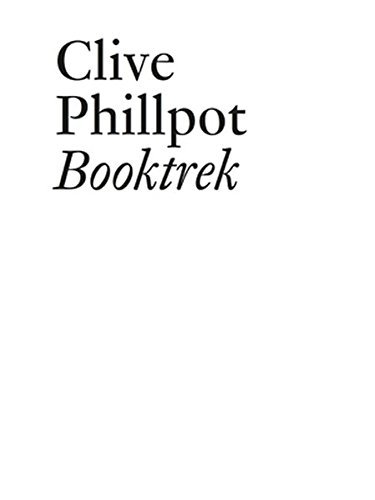
Booktrek
Clive Phillpot
Clive Phillpot has been a tireless advocate for the artist’s book for more than 40 years--both as a critic, curator and editor, and in his tenure as director at the library of The Museum of Modern Art in the late 1970s, where he built the library’s collection of artist’s books and mapped out the field with influential essays that traced its ancestry and distinguished it from seemingly similar genres such as the livre d’artiste. As he has delineated the genre: “Artists’ books are understood to be books or booklets produced by the artist using mass-production methods, and in (theoretically) unlimited numbers, in which the artist documents or realizes art ideas or artworks.” Also collaborating with Printed Matter and Franklin Furnace, among other places dedicated to the medium of the book, Phillpot helped raise awareness of artists’ books, endowing them with the critical credentials to enter the collections of museums. Booktrek gathers for the first time Phillpot’s essays on the definition and development of artists’ books from 1972 to the present--historical texts, manifestos, catalogue entries and essays on works by Ed Ruscha, Sol LeWitt, Dieter Roth and Richard Long. Booktrek will prove an invaluable reference for all those interested in the evolution of the artist’s book, and offers a crucial account of the genre’s ascent.
0 notes
Text
Assignment two - Collecting
‘Fragments of a vessel which are to be glued together must match one another in the smallest details although they need not be like one another.’ - Walter Benjamin (1936) 1999, p.79
Hand written notes:

Things
Hiroshima by Ishiuchi Miyako
sources: https://www.youtube.com/watch?v=csVx_QRPvps
http://blogs.getty.edu/iris/inside-the-photography-of-ishiuchi-miyako/
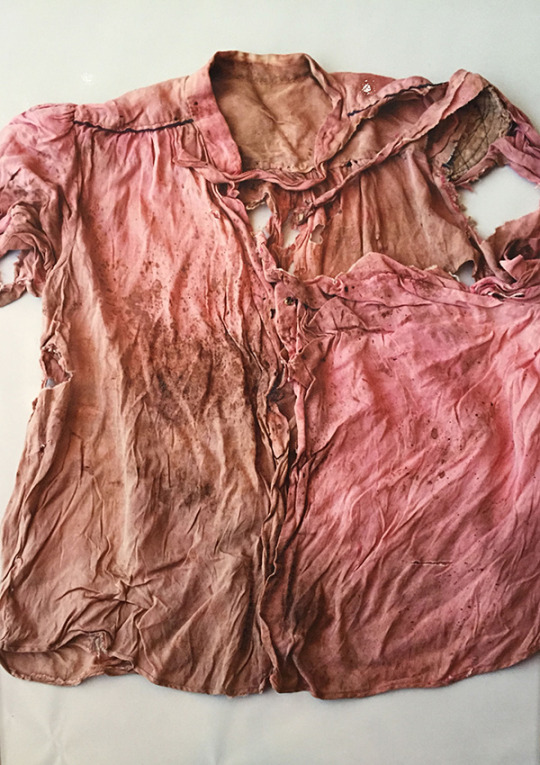
Hiroshima by Japanese photographer Ishiuchi Miyako is a book showing items from the Hiroshima Peace Memorial Museum.
There was a lot of famous work coming out of Japan in the 1960s documenting the aftermath of the nuclear disaster and this is more contemporary work which deals with the same issue in a modern way.
It mostly contains items of clothing, but also shows accessories such as hair combs and eye glasses as well as shoes.
These photographs were mostly shot on a light table but now Miyako relies on natural light to illuminate her photographs and on duller days she sets up a lamp.
The book presents subtle design in a simple way as not to overcomplicate the issues and to focus only on the disaster which took place and not the artist herself.
Seeing the photographs of Miyako in colour is a completely different experience than viewing the well known photographs of the 1960s in black and white. As Jörg Colberg said, “I don’t want to say that any one is better, just different.” I think that adding colour to these photographs really brings them to life and helps the viewer to see the disaster as a real life event, just like most of us see today’s reality in colour.
Amanda Maddox describes these photos as having a ‘ghostly presence.’ I agree with this way of seeing the photographs as they often appear transparent and lifted off the page. In this way, Miyako communicates that these people are dead and their tattered posessions are all that remains of the lives that once were.
Views
Twentysix Gasoline Stations by Edward Ruscha
source: https://www.tate.org.uk/about-us/projects/transforming-artist-books/summaries/edward-ruscha-twentysix-gasoline-stations-1963
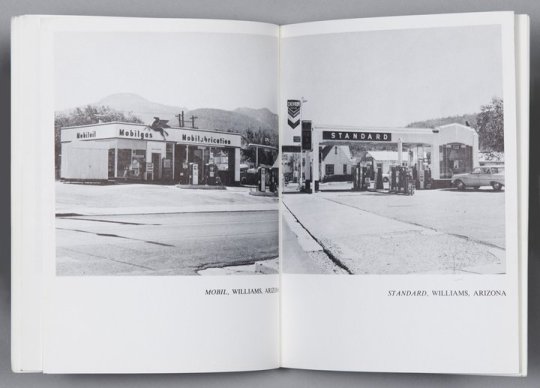
Twentysix Gasoline Stations is a black and white photobook by Edward Ruscha and contains photographs of petrol stations, along the highway between Ruscha’s home in Los Angeles and his parent’s house in Oklahoma City.
The photographs in this book are not all presented in a linear sequence as five photos are presented out of order. This was noticed by curator Clive Phillpot.
Because they have been taken from the highway, they all contain quite large amounts of foreground and they all appear as factual observational shots.
Writer and critic Johanna Drucker commented, “ in 1962 this work read against the photographic landscape of highly aestheticized image-making work which carried photography’s claims to art status forward on the double engines of fine art imagery and/or humanistic critical vision.”
In other words, these photographs represent the urban landscape in a completely new way. They do not intend to show beauty or aestheticism, they are simply a documentation of a view which exists in space. This differs from artists such as Ansel Adams who was very much interested in capturing ‘the beautiful’ in his work.
These photographs alone are something I don’t find particularly interesting and I think many people would agree. However, the concept of taking a standard view like this and presenting it as a collection is a journey that the photographer has chosen to take you with him on.
Heads
Untitled by Bettina von Zwehl
sources: http://www.bettinavonzwehl.com/archive.html
http://www.artnet.com/artists/bettina-von-zwehl/6-from-untitled-ii-MYK4uvlOSqh-KeSMk5epIQ2
The Photograph As Contemporary Art by Charlotte Cotton (2004) Thames and Hudson, ISBN 978-0-500-20418-4, pgs.31-32
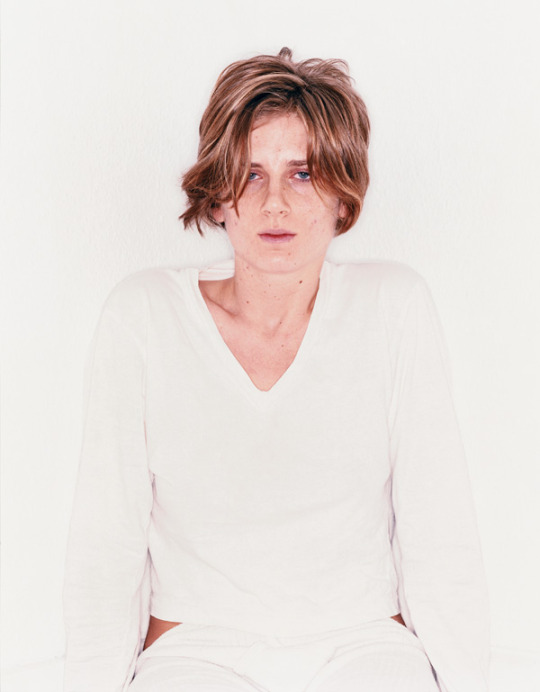

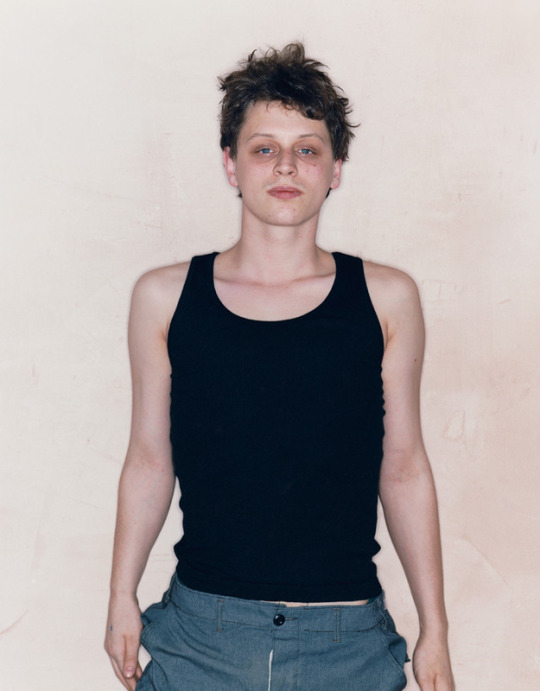
Bettina von Zwehl created three untitled series where the sitters are given instructions that disarm them and prompt less self-conscious gestures for the camera.
Their appearance is not controlled by them. For all three parts Zwehl asks her sitters to wear clothes of a certain colour and agree to undertake simple tasks.
In Untitled 1 Von Zwehl got her subjects to go to sleep wearing all white clothes. They were then woken and photographed whilst their tiredness was still displayed on their faces.
Untitled 2 features different subjects all wearing blue polo-neck jumpers photographed after physically exerting themselves. Their faces are flushed although they try to remain composed. Untitled 1 and Untitled 2 were both taken in 1998.
Untitled 3 has new subjects once again. They all wear black vests. Von Zwehl has photographed them from above as they lay down on her studio floor and try to hold their breath. They appear strained. These portraits were taken in 1999.
When you ask your subject if you can take their portrait, they will normally try to prune themsleves beforehand to make their appearance as attractive as possible. In these untitled series, Von Zwehl takes away this opportunity from her subjects by controlling their activities beforehand and then sitting them naturally.
I think this is an interesting way to look at portraiture as each subject is captured in their most natural state and their appearance is somewhat fixed by the photographer.
Hand written notes and print outs:
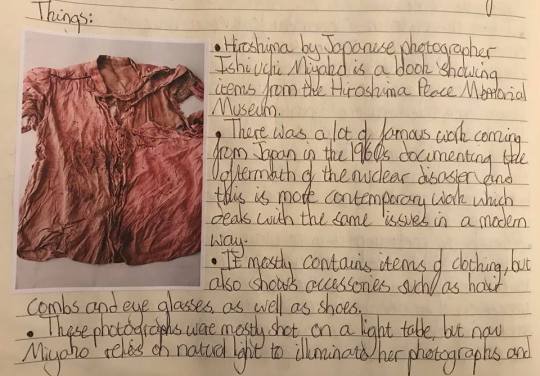
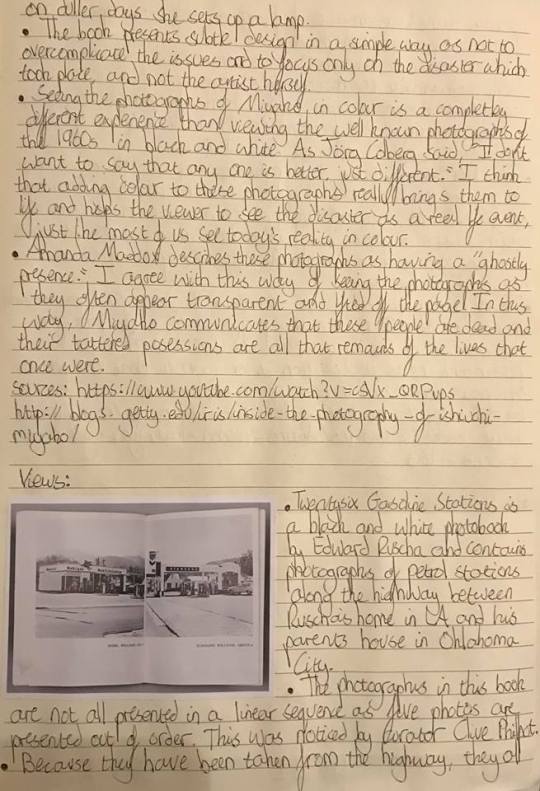
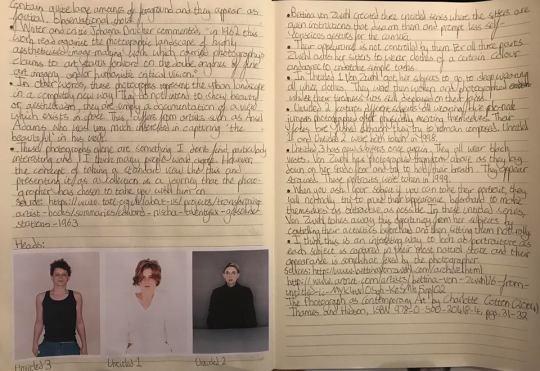
Planning:
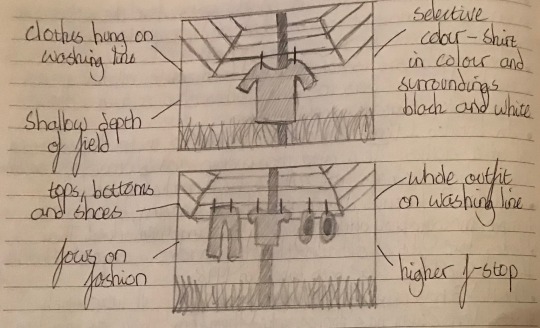
Contact Sheets:

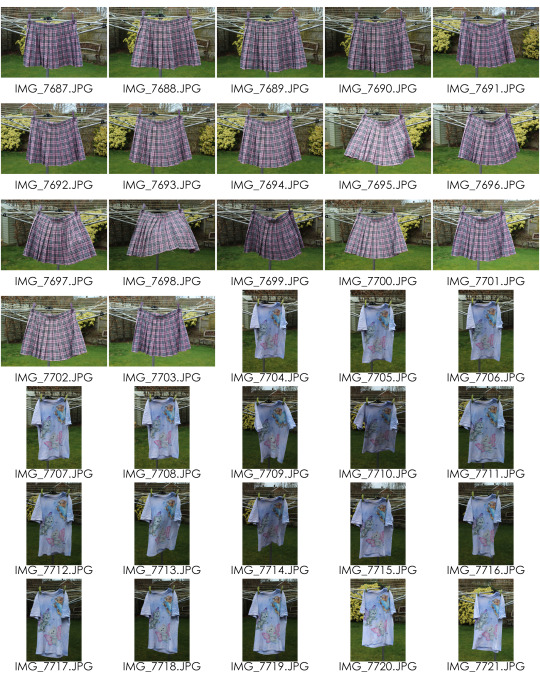
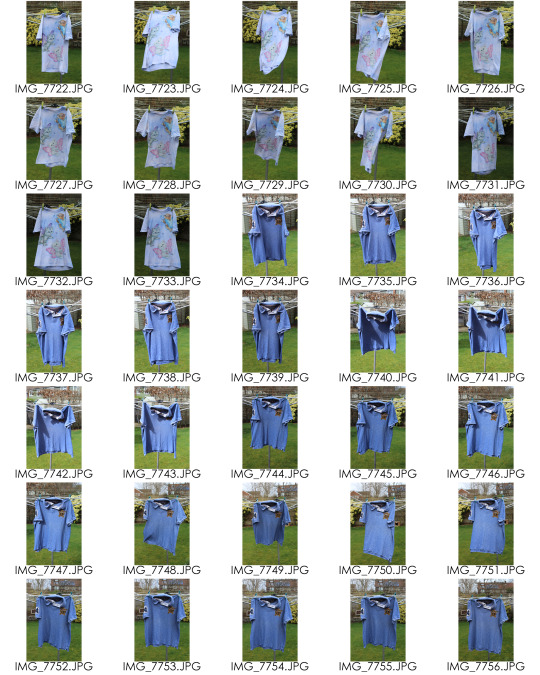
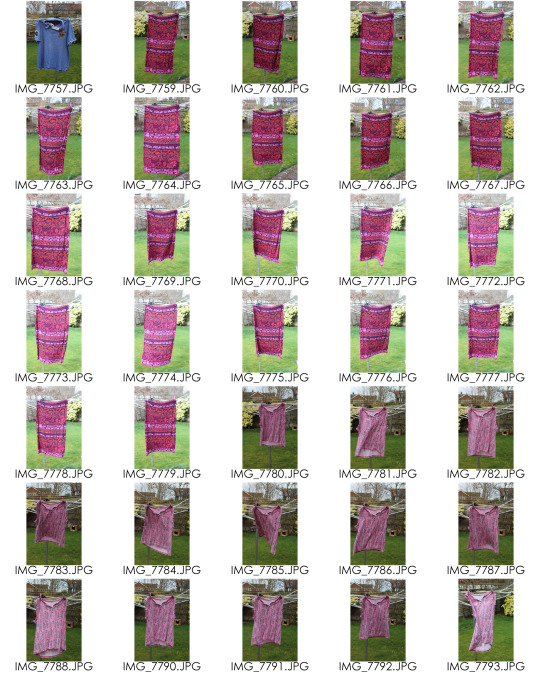
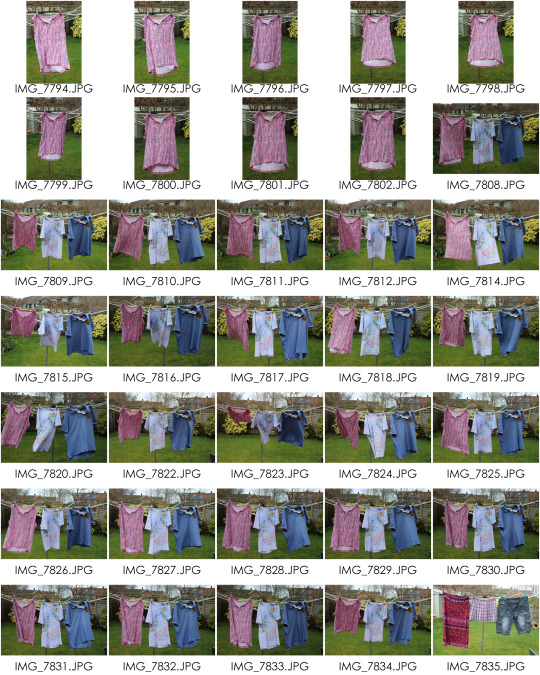
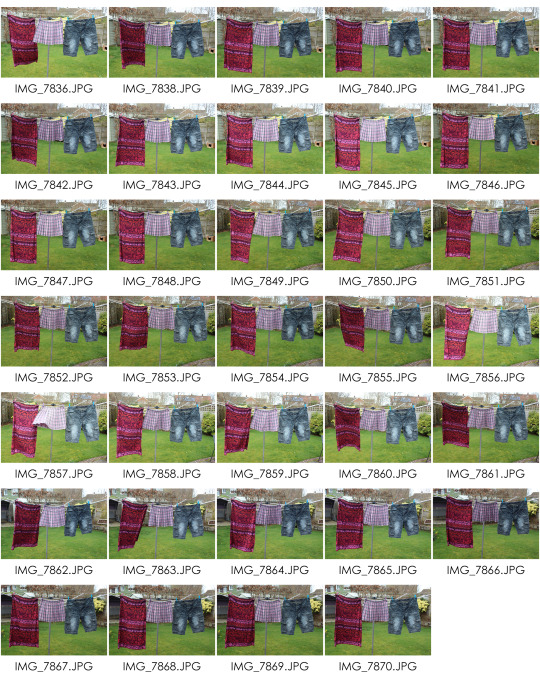
My final edits:
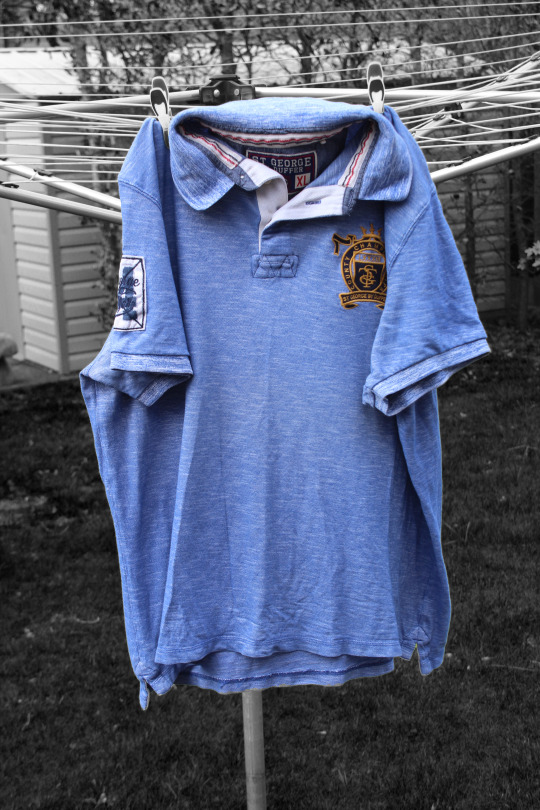
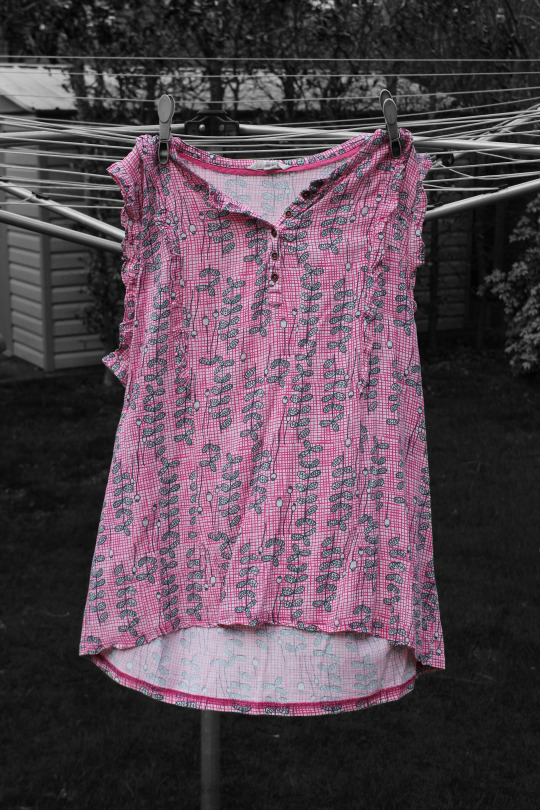

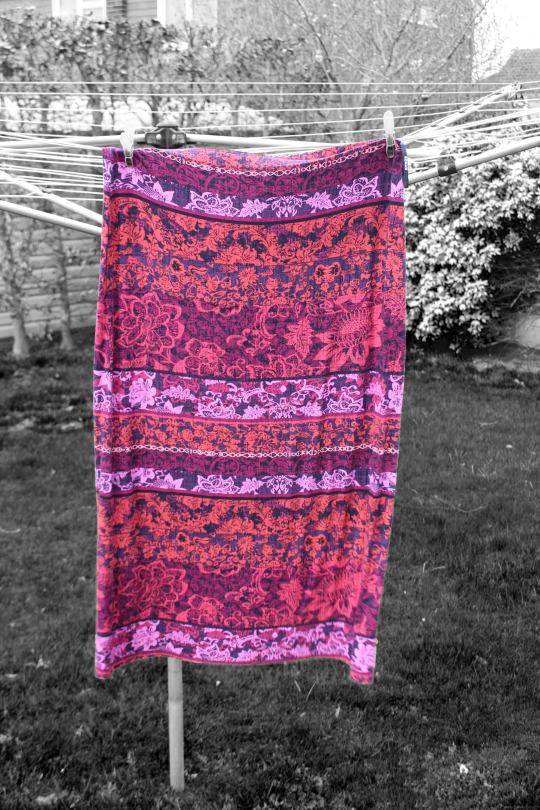
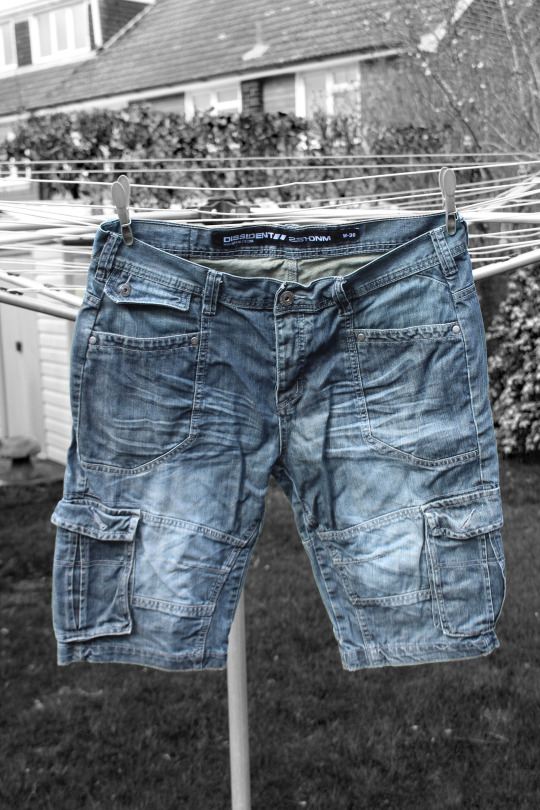
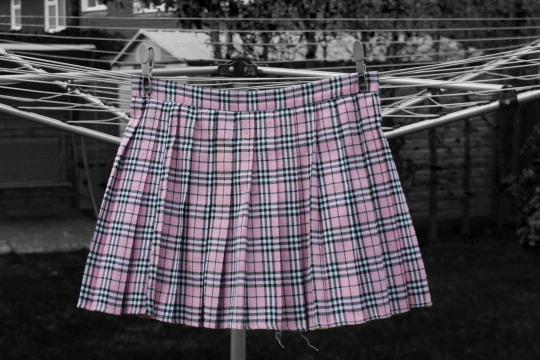
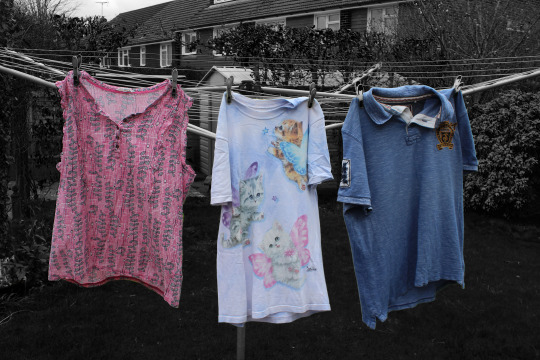
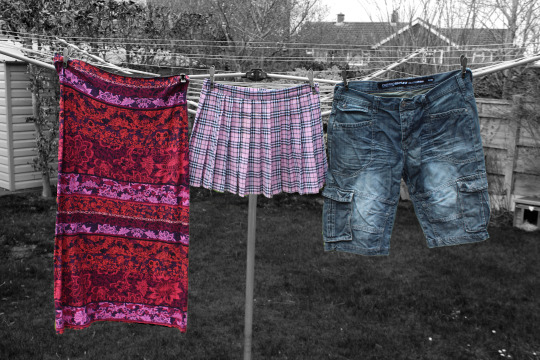
Assignment notes:
I love photographing people. Nothing intrigues me more than observing the human body and seeing how it works and moves through a camera lens. It is fascinating to see how people behave in front of the camera which is why I chose to do some further research on Bettina von Zwehl who takes away this instinctive autonomy. Her sitters are given instructions and then posed in a controlled way. They are also dressed in a directed way.
Ishiuchi Miyako looks at clothes from Hiroshima and photographs them in a very simple and striking way. Von Zwehl and Miyako both use clothing to communicate in their work in very different ways. Von Zwehl eliminates a sense of identity through her garment choices but Miyako does the opposite and highlights it. Although both photographers have produced conceptually interesting work, I don’t find the photographs themselves hugely dynamic or moving. Similarly, Edward Ruscha took a series of seemingly mundane photos – they were of petrol stations - which in fact had a huge impact on the acknowledgement of photography as an art form.
When I first looked at the brief for this assignment, my initial reaction was to take it down the route of ‘things’ and photograph fashion. I put this under the category of ‘things’ rather than ‘heads’ because I had planned to photograph the clothes hugging people’s skin and wrapped around their body’s and have my images cropped in, so their faces weren’t even visible.
My idea developed into removing the person from my photographs all together. Fashion doesn’t have to be modelled and it can still hold the impression of a person and their identity. I live at home with a small family of three; my parents and me. Each of us can be easily told apart not just by our physical appearance but also by our largely different styles of clothing. To make this shoot work I chose some of the most colourful clothes from each of our wardrobes.
To photograph single garments, I used a shallow depth of field. This way, I was able to focus entirely on the garment and have a soft blurred background. For these shots I used between f/5 and f/10 with my camera on aperture priority mode. The day I took these photos was very windy and the natural light available changed as the clouds moved over the sun, which is why there is a small difference in my f-stop between photos. To capture the garments together and still have this blurred effect in the background I stood further back from the subject, maintained a low f-stop and zoomed in, like the technique I used in exercise 2.3 to take a portrait.
What I have pictured here is a mundane home activity, hanging the laundry on the line. The photographs themselves are relatively simple and I found them to be messy in full colour what with the lines cutting across the frame and the several layers appearing in the background. This is what inspired me to put them in black and white. Having experimented with this on Photoshop, I realised my images were still lacking a main point of interest which is when I decided to use the selective colour technique.
To apply selective colour to my photos, I first loaded my image into the software and duplicated the layer. Using the quick selection tool, I highlighted the garment and separated this into a separate layer mask. I then applied the black and white filter and adjusted the toggles of the duplicate image to enhance the garments and make them stand out. Through adding this effect, I have tried to symbolise and represent the individuality of each member of my family in a collection of our clothes. This project has taken on the main theme of identity so in a way, I started this assignment with ‘things’ and ended it with ‘heads.’
Reflection:
Demonstration of technical and visual skills - I used the aperture priority mode on my camera to ensure that my f-stop was visually appealing.
Quality of outcome - I determined that my outcomes needed adjusting to help them stand out so I edited them accordingly.
Demonstration of creativity - I have tried to turn something mundane into a conceptually interesting project.
Context - I have researched three different practitioners and referenced them in my notes as inspiration.
Hand written notes and print outs:
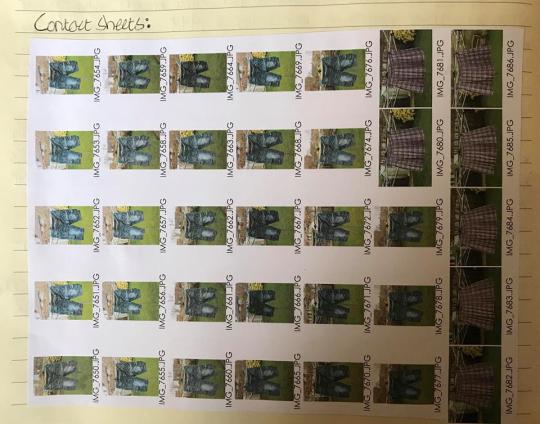
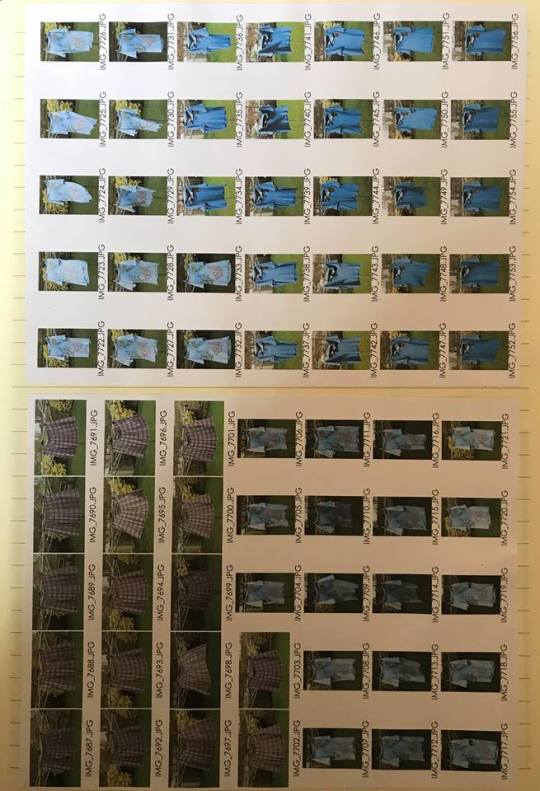
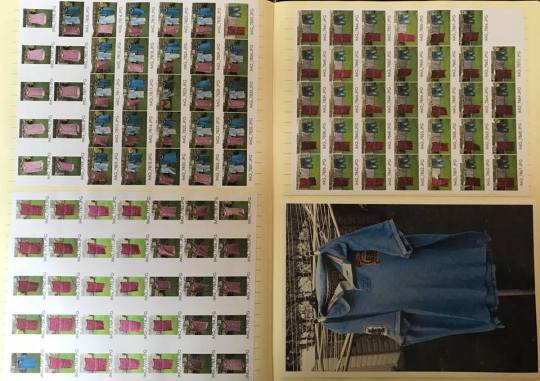
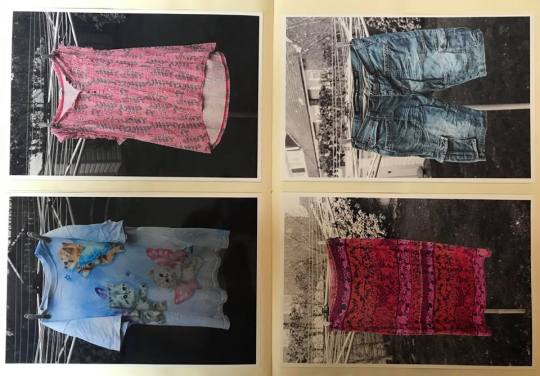

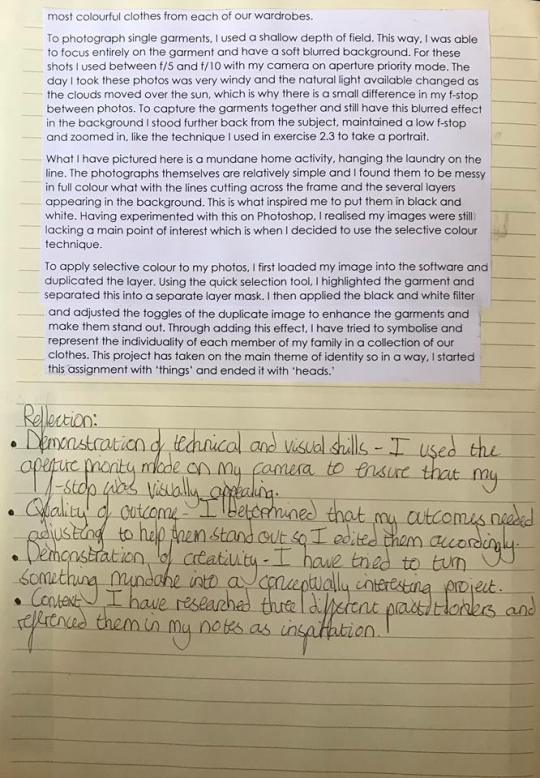
Bibliography
Benjamin W. (1999) Illuminations. In W. Benjamin, Illuminations (p.79) Pimlico; New Ed edition
Colberg J. (17th August 2011) Presenting Hiroshima by Ishiuchi Miyako, Retrieved from Youtube: https://www.youtube.com/watch?v=csVx_QRPvps
Maddox A. (6th August 2015) Inside the Photography of Ishiuchi Miyako, Retrieved from the iris: http://blogs.getty.edu/iris/inside-the-photography-of-ishiuchi-miyako/
Edward Ruscha 'Twentysix Gasoline Stations' 1963 (n.d.) Retrieved from Tate: https://www.tate.org.uk/about-us/projects/transforming-artist-books/summaries/edward-ruscha-twentysix-gasoline-stations-1963
Archive (n.d.) Retrieved from Bettina von Zwehl: http://www.bettinavonzwehl.com/archive.html
Past Auction (n.d.) Retrieved from artnet: http://www.artnet.com/artists/bettina-von-zwehl/6-from-untitled-ii-MYK4uvlOSqh-KeSMk5epIQ2
Cotton C. (2004) The Photograph As Contemporary Art. In C. Cotton, The Photograph As Contemporsry Art (pgs.31-32) Thames & Hudson world of art
Reshoot
After talking with my tutor and assessing my images through feedback, I have realised that my final photographs could be refined. Therefore I decided to reshoot this assignment to make my photos more consistent and better executed.
Contact Sheets:

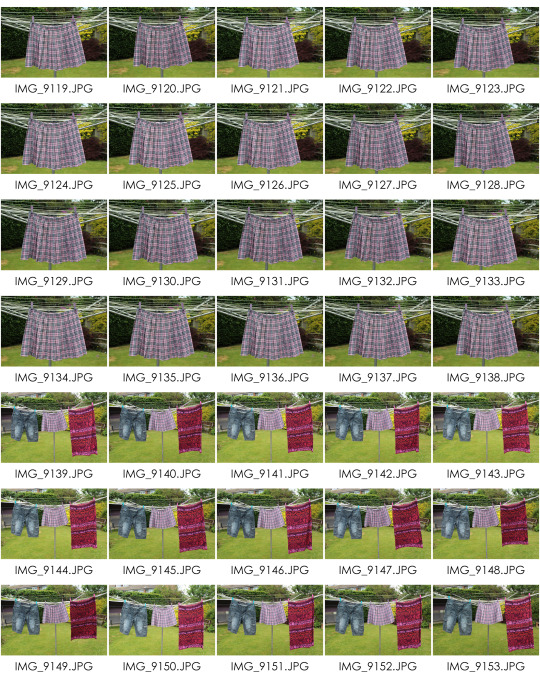

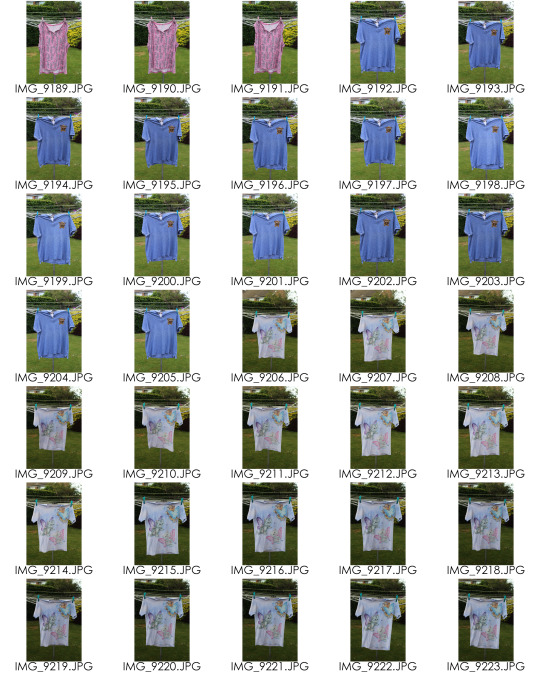
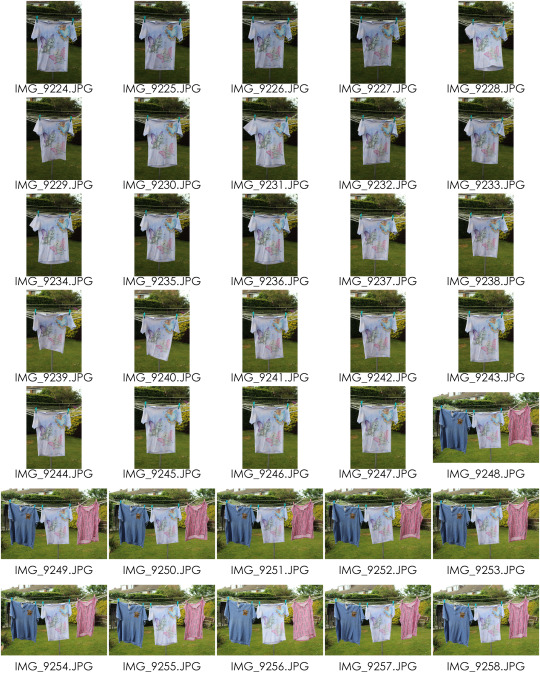
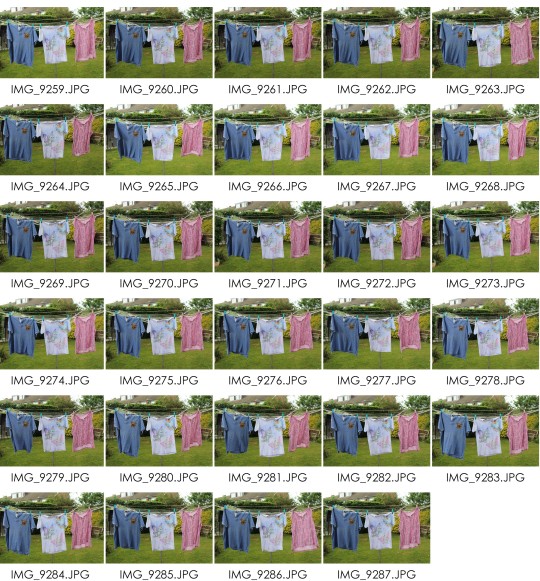
Final Edits:
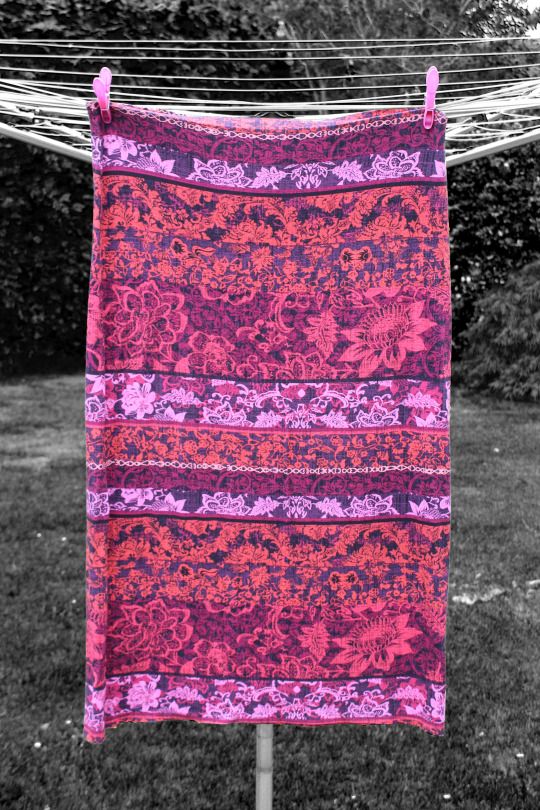
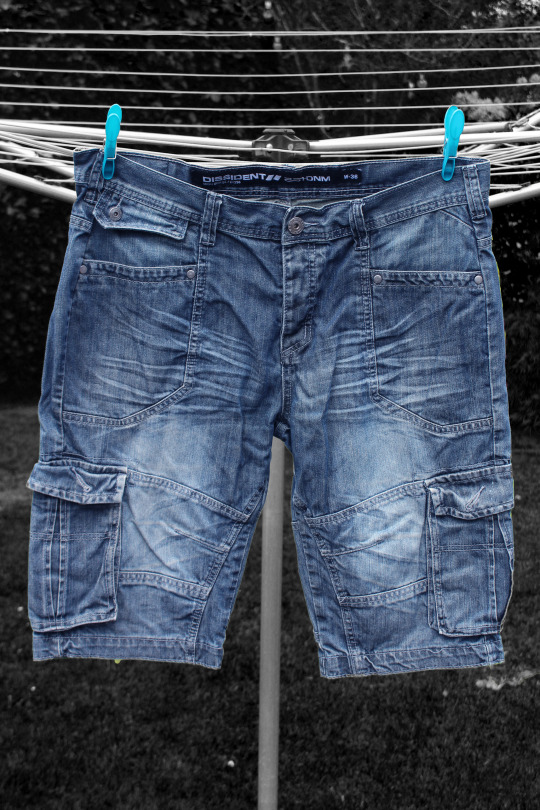
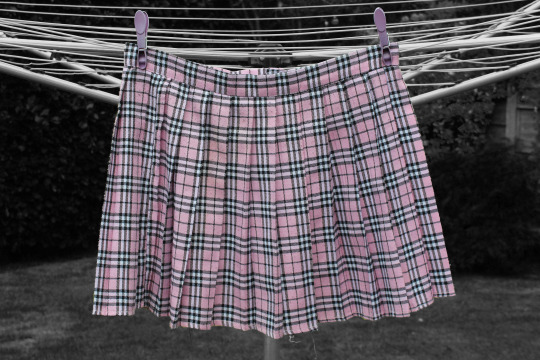
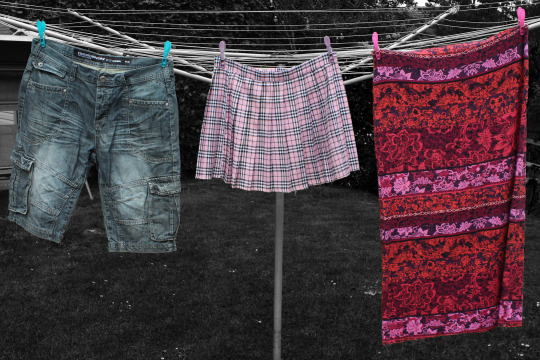
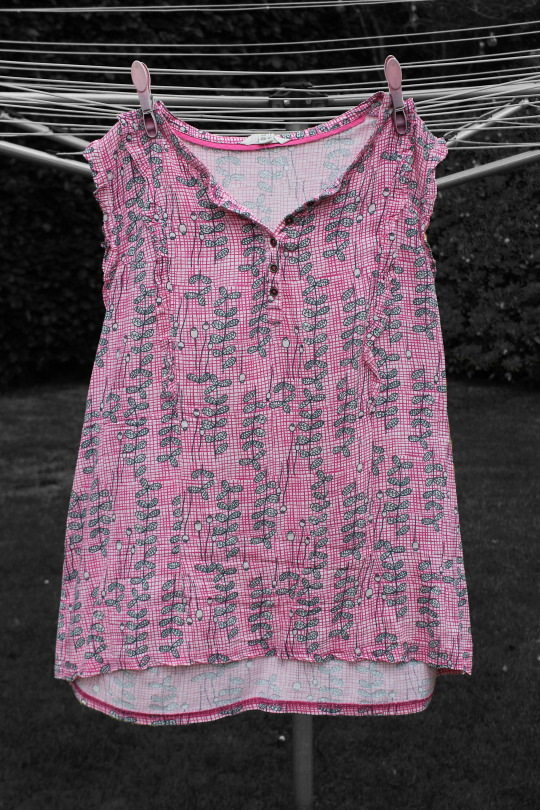
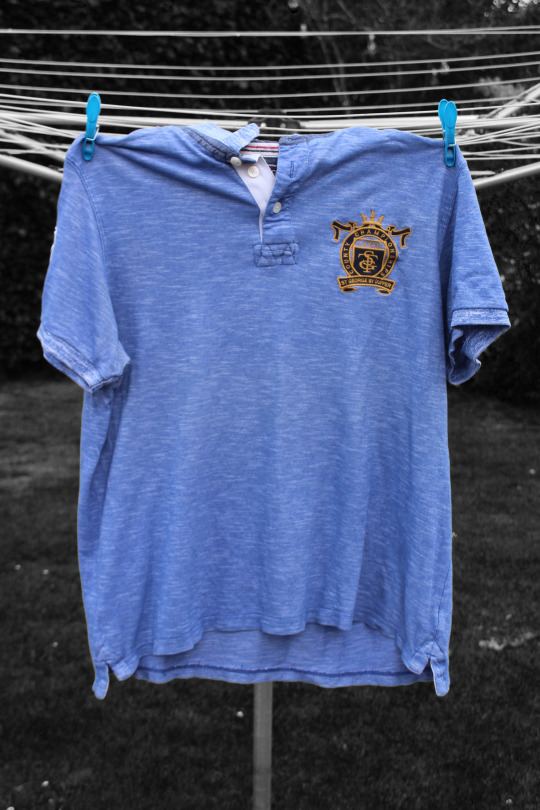
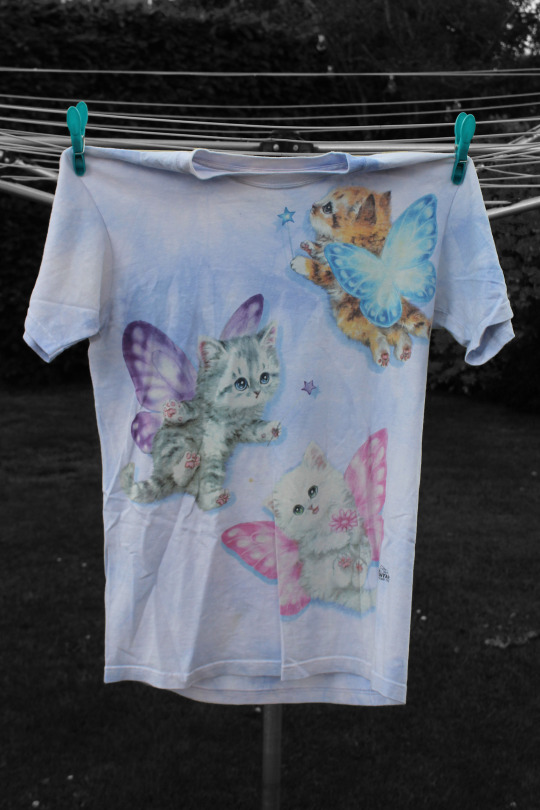

In this reshoot the main thing I have focussed on correcting is the framing. I took the photos through the viewfinder of my camera and tried to line them up as best as I could but of course there is the factor of natural human error. Therefore, in post production I used a grid to crop my images so that they are as symmetrical and well aligned as possible. I also shot all of these photos in the same position and direction in my garden, making them as consistent to one another as possible.
There are two reasons I decided to hang my clothes from a washing line as opposed to laying them flat on the ground. The first is that, as I have previously mentioned, this shoot is about the mundanity of life and hanging up the washing is a simple household chore. More importantly, I am representing the clothes as people, without actually shooting portraits so I wanted my clothes to hang and reflect the way they would naturally hang from a person’s body.
Hand written notes and print-outs:

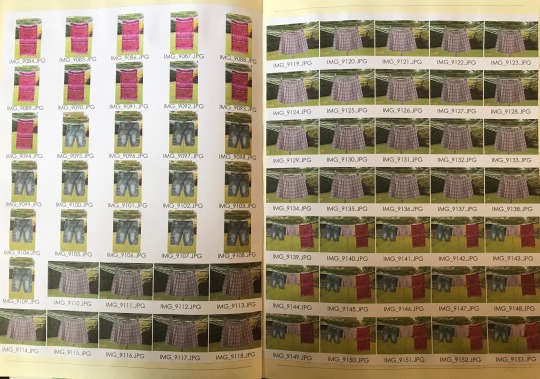
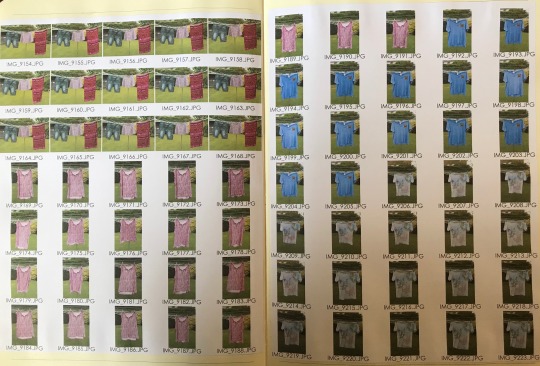
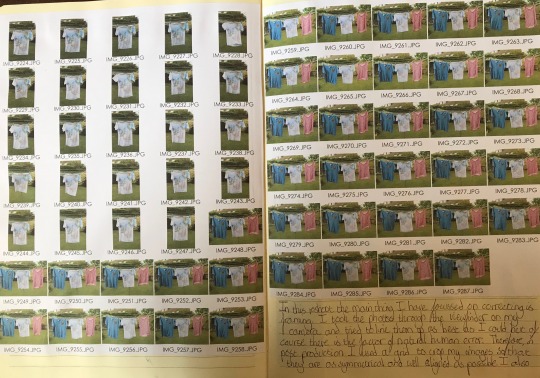
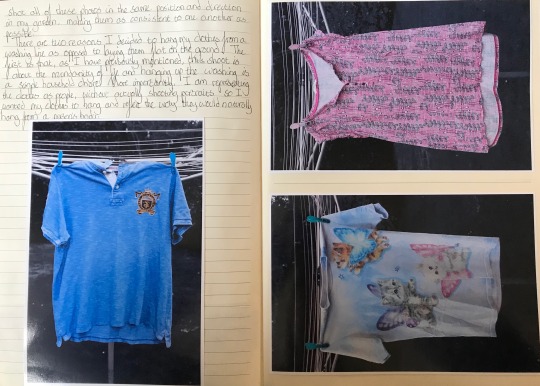
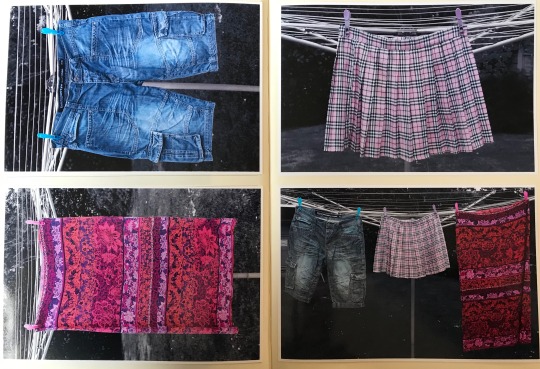
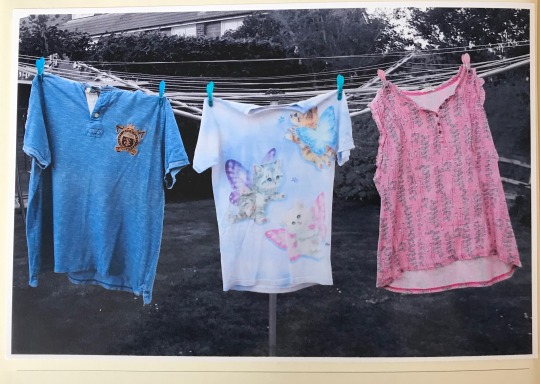
#art#photography#photograph#collecting#walter benjamin#ishiuchi miyako#edward ruscha#bettina von zwehl#laundry#fashion#clothes#garments
0 notes
Photo


Fluxus: Selections from the Gilbert and Lila Silverman Collection
#tbt to MoMA’s first exhibition on Fluxus, comprised of works from Gilbert and Lila Silverman’s renowned collection of works from this radical artistic experiment, which they donated to MoMA 20 years later. Fluxus was a 1960s movement that brought together an international group of artists, designers, composers, and writers—including Yoko Ono, Nam June Paik, and George Maciunas, among many others—who opposed the concept of the art object as a nonfunctional commodity. In pursuit of expanded possibilities for art, Fluxus artists tended toward nontraditional and ephemeral forms such as performance, mail art, and inexpensive publications. The works on display at the Museum included instruction drawings, correspondence, photographs, and other ephemera from this elusive movement. Curated by Clive Phillpot, the director of the MoMA Library, the exhibition was installed in the Library, on shelves and in card catalogues through which visitors were invited to rummage, underscoring the inquisitive, experimental essence of the movement.
Read the out-of-print catalogue, see installation views, and more at mo.ma/2nH87Ca. 30 of #52exhibitions #MoMAhistory
#art#moma#MoMA Collection#Modern Art#fluxus#52exhibitions#MoMA Library#The Museum of Modern Art#George Maciunas#nam june paik#yoko ono
109 notes
·
View notes
Text
29 October - 2 November
Publishing Workshop initiated by Mike Sperlinger, with Nate Pyper, João Doria and Vibeke Luther O'Rourke
Based in KhiO's Publishing Studio, this intensive one week course – engaging students from Kunstakademiet and Kunst og Handwerk – will explore the medium of “publishing as artistic practice”. The course will be led by a guest teacher, designers Nate Pyper and João Doria.
Students will have a problem-solving experience: developing ideas through the hands-on process of making an artist’s book. The basic starting point will be a set of images/photos which you bring to the course. Depending on the nature of your practice, that might mean a set of found photographs to be collaged, your own photographs, documentary images of your artworks, or something else entirely.
The workshop will combine book-arts with image and text driven content supported by lectures, presentations, technical demonstrations, group discussions, one to one tutorials and audience feedback. Parts of the course will be documented as a record of the production process and there will be a presentation of students’ maquettes at the end of week.
Participants will be expected to prepare material in advance, to attend the whole course and to take an active role in all aspects of the process, learning to apply traditional bookbinding tools and digital printing equipment in innovative ways.
Literature:
-Unshelfmarked: Reconceiving the artist’s book, Michael Hampton. Published by Uniformbooks, 2015. -Artists’ Books, The Book as a Work of Art 1963-2000, Stephen Bury. Published by Quaritch, 2015 -Art and Text, Dave Beech. Black Dog Publishing, 2009 -Writing on the Wall: Word and Image in Modern Art, Simon Morley. University of California Press, 2005
- Publishing as Artistic Practice, Annette Gilbert, Sternberg Press 2017
- Post Digital Print, the mutation of publishing since 1894 by Alessandro
Ludovico, Onomatopee 2012
- Booktrek by Clive Phillpot, JRP Ringier 2013
- Dispersion by Seth Price, 2002 http://www.distributedhistory.com/Dispersion2007.comp.pdf
Litia Perta's "Against Curation or Losing Your Grip" http://www.litiaperta.com/writing-bodies/
David Reinfurt, "G-E-S-T-A-L-T" http://www.servinglibrary.org/journal/5/g-e-s-t-a-l-t
https://paper.dropbox.com/doc/181101-Riso-Color-separation-VetOGU4Z5tW0po9AAjjoh
0 notes
Photo

OPEN TODAY 12-4 PM. BACK IN THE BOOKSHOP: PLEASE COME TO THE SHOW (Occasional Papers, 2014) David Senior, bibliographer at the Museum of Modern Art Library in New York, selected a wide range of exhibition-related ephemera – invitations, flyers and posters from the 1960s to the present – and presents them here as an historically overlooked but integral aspect of exhibitions. Often the first point of contact between the audience and artist, such items form part of an essential lexicon for graphic designers, curators, art historians and anyone interested in the event-based nature of showing art. Filled with full-colour reproductions of numerous examples from the MoMA collection, the book includes new essays and analysis by Angie Keefer, Clive Phillpot and Will Holder, among others. In the bookshop today and via our website. #worldfoodbooks #occasionalpapers #davidsenior #martinkippenberger (at WORLD FOOD BOOKS)
1 note
·
View note